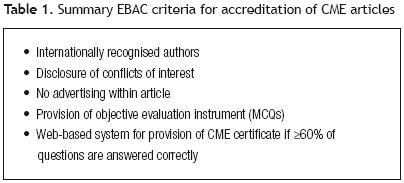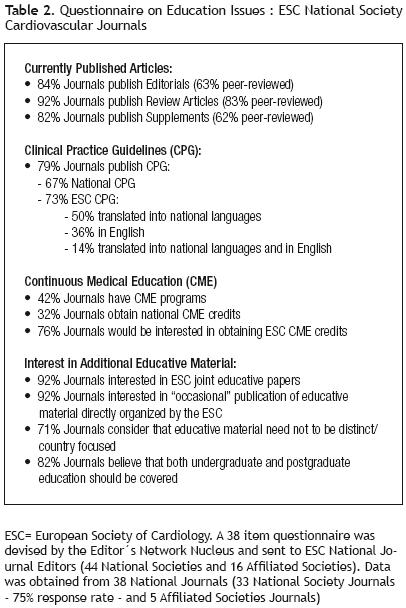Servicios Personalizados
Revista
Articulo
Indicadores
-
 Citado por SciELO
Citado por SciELO -
 Accesos
Accesos
Links relacionados
-
 Similares en
SciELO
Similares en
SciELO
Compartir
Archivos de cardiología de México
versión On-line ISSN 1665-1731versión impresa ISSN 1405-9940
Arch. Cardiol. Méx. vol.79 no.4 Ciudad de México oct./dic. 2009
Artículo especial
The role of European National Journals in Education
El papel de las Revistas Nacionales Europeas en la Educación
Peter Mills,1 Adam Timmis,2 Kurt Huber, Hugo Ector,3 Izet Masic, Mario Ivanusa, Loizos Antoniades, Michael Aschermann, Alexandras Laucevicius, Pirjo Mustonen, Jean–Yves Artigou, Panos Vardas,4 Christodoulos Stefanadis, Massimo Chiarello, Leonardo Bolognese, Guiseppe Ambrosio,5 Ernst E. van der Wall, Piotr Kutakowski,6 Fausto J. Pinto,7 Eduard Apetrei, Rafael G. Oganov, Gabriel Kamensky, Thomas F. Lüscher, René Lerch, Habib Haouala, Vedat Sansoy, Valentin Shumakov, Carlos Daniel Tajer,8 Chu–Pak Lau,8 Manlio F Márquez,8 Rungroj Krittayaphong,8 Kaduo Arai,8 y Fernando Alfonso9
European Society of Cardiology (ESC) National Society Cardiovascular Journals Editors and ESC Affiliated Societies Cardiovascular Journals Editors, see Appendix for complete affiliations.
1 Education Editor, Heart (UK) Editor's Network Task Force:
2 Editor–in–Chief, Heart (UK).
3 Editor–in–Chief, Acta Cardiológica (BE).
4 Editor–in–Chief, Hellenic Journal of Cardiology (GR).
5 Former Editor–in–Chief, Cionale Italiano di Cardiología (IT).
6 Editor–in–Chief, Kardiologia Polska (PL).
7 Editor–in–Chief, Revista Portuguesa de Cardiología (PT).
8 ESC Affiliated Societies Cardiovascular Journals Editors, see Appendix for complete affiliations.
9 Editor–in–Chief, Revista Española de Cardiología (ES) and chairperson of the Editors' Network.
Corresponding author:
Adam Timmis MD,
Dept Cardiology, London Chest Hospital,
Bonner Road, London E2 9JX, United Kingdom
E–mail: adamtimmis@mac.com
Received: October 12, 2009.
Accepted: October 26, 2009.
This manuscript will be simultaneously published in all ESC National Societies and ESC Affiliated Societies' cardiovascular journals that consented to publication.
The Editors' Network of the European Society of Cardiology (ESC) defined its mission in the statement published across the national cardiac journals of Europe in 2008.1 The Network is now considering ways in which their publications can have a broader influence in the field of postgraduate education.
The need for cardiologists to continue to learn throughout their professional life will remain essential. Indeed recognition for the need for postgraduate education was highlighted by Hippocrates long before it was espoused by medical educators and Public Relations Departments. Ars longa, vita brevis is the Latin translation of Hippocrates recognition that for a doctor, the need to continue learning the art of medicine lasts for all of our professional life. In medieval times, the foundation of modern day ethical medical practice laid within the heart of the Universities; the long–term future of the medical profession was founded in the concept of doctors as men and women of learning and knowledge, rather than the purveyors of non–scientifically based remedies.
So how does the modern–day Editor of a National Cardiology Journal, crouched over his computer screen, relate to his medieval predecessor, the Abbot in charge of the University Library selecting the books for scholarly enterprise? The most obvious difference, of course, is that the Internet provides modern–day authors with easy access to the Editor and consequently the Editor is obliged to make judgements on a much larger number of manuscripts than his predecessor would have been asked to do (Figure). The academic effort however is potentially very valuable, allowing the Editor to accumulate the current wisdom bywhich writers combine both the knowledge of cardiovascular medicine, with the style with which to communicate that knowledge, in an authoritative way to doctors who wish to learn.

What are the characteristics of doctors who wish to learn? As adults, they prefer a self–directed approach, in which they identify their own learning needs, formulate learning objectives, identify resources to achieve these objectives and evaluate their own learning.2 Medical journals provide a ready resource for meeting the aims of self–directed learning, particularly through their commentary and review articles, but the value of the resource is critically dependent on the quality of the content, which in turn depends on three factors:
1. Subject selection: ideally this should be curriculum–based, the core curriculum of the ESC intending to provide a framework for the continuing medical education of the general European Cardiologist. Both mainstream and more peripheral subject matter are required for comprehensive educational coverage, and so there will be a need for updates, particularly in areas where new discoveries are proceeding most rapidly.
2. Author selection: Editors are in an unrivalled position to select from currently active authors; those best able to educate others based on their subspecialty expertise and writing skills. Clear presentation must be coupled with the intellectual rigor to back up assertions with evidence derived from critical appraisal of the relevant literature.
3. Presentation: this should be designed to help stimulate the reader, using highly structured content, relevant illustrations, summary box displays, and annotated references that allow the reader to refer back to source material.
Adults who wish to learn, however, require more of medical journals than high quality commentary and review articles. They also require educational feed–back provided by accrediting organisations in order to consolidate their learning and acquire the continuing medical education (CME) credits that in many countries are becoming an essential requirement for practising doctors. The European Board for Accreditation in Cardiology (EBAC), for example, requires that cardiologists earn a minimum of 250 CME credits over a period of five years, 125 of which must be "external CMEs" from formally planned external activities, including educational articles.3 The EBAC accreditation policy for CME articles is summarised in Table 1 and includes a requirement for "an objective evaluation instrument", recommending the use of a multiple choice questionnaire (MCQ) made available on–line. Articles of –3,500 words and 6 MCQs are considered equivalent to one hour of educational activity and provide 1 CME credit.

Nearly all the national cardiac journals of Europe carry high quality review articles (Table 2).4–7 Heart, the UK–based international cardiac journal, has been a leader in the field of journal–based education for 10 years,8 and currently accounts for >95% of educational articles attracting CME credits on the EBAC web site. Its educational section runs semi–autonomously within the journal under the direction of a dedicated editor and a team of specialist advisors. Education in Heart is available for free access via the Heart and ESC web sites9,10 and its articles are among the most highly accessed of all the journal's papers, consistently appearing in the top ten web–downloads during 2008.11–15 High quality educational content with provision of local CME credits is also available in other national cardiac journals16–17 (Table 2) and The Editors' Network now provides a real opportunity to extend these educational initiatives throughout the national cardiology journals of Europe.10

References
1. Alfonso F, Ambrosio G, Pinto FJ, Van der Wall EE, Kondili A, Nibouche D, Adamyan K, Huber K, Ector H, Masic I, Tarnovska R, Ivanusa M, Stanék V, Videbaek J, Hamed M, Laucevicius A, Mustonen P, Artigou J–Y,Cohen JY, Rogava M, Bohm M, Fleck E, Heusch G, Klawki R, Vardas P, Stefanadis C, Tenczer J, Chiariello M, Elias J, Benjelloun H, Rodevand O, Kutakowski P, Apetrei E, Lusov VA, Oganov RG, Obradovic V, Kamensky G, Kenda MF, Hoglund C, Lüscher TF, Lerch R, Jokhadar M, Haouala H, Sansoy V, Shumakov V, Timmis A. European National Society cardiovascular journals. Background, Rationale and Mission Statement of the "Editors' Club" (Task Force of the European Society of Cardiology). Heart. 2008;94:e19. [ Links ]
2. Kaufman DM. ABC of learning and teaching in medicine: Applying educational theory in practice. BMJ 2003; 326: 213 –216 [ Links ]
3. European Board for Accreditation in Cardiology. http://www.ebac–cme.org/index.php (accessed 18/9/09) [ Links ]
4. Ramos PM, Martínez VB, Granado JQ, Juanatey JR. [Advances in hypertension and diabetes in 2007]. Rev Esp Cardiol. 2008;61 Suppl 1:58–71. [ Links ]
5. Selton–Suty C, Juillière Y. Non–invasive investigations of the right heart: How and why? Arch Cardiovasc Dis. 2009;102:219–32. [ Links ]
6. Maas AH, Franke HR. Women's health in menopause with a focus on hypertension. Neth Heart J. 2009;17:68–72. [ Links ]
7. Stefanatou A. Smoking cessation in cardiovascular patients. Hellenic J Cardiol. 2008;49:422–31. [ Links ]
8. Timmis AD. Education in Heart: 10th anniversary. Heart 2009;95:1555. [ Links ]
9. Heart, http://heart.bmj.com (accessed 18/9/09) [ Links ]
10. European Society of Cardiology, http://www.escardio.org/membership/national–societies/Pages/journals.aspx (accessed 18/9/09) [ Links ]
11. Peter R, Cox A, Evans M. Management of diabetes in cardiovascular patients. Heart 2008; 94: 369–375. [ Links ]
12. Grayburn PA. How to measure severity of mitral regurgitation. Heart 2008 94: 376–383. [ Links ]
13. Konstantinides SV. Acute pulmonary embolism revisited. Heart 2008 94: 795–802. [ Links ]
14. Wu AH. Cardiotoxic drugs: clinical monitoring and decision making. Heart 2008; 94: 1503–1509. [ Links ]
15. Jukema JW, Bergheanu SC. Statins: established indications and controversial subgroups. Heart 2008; 94:1656–1662. [ Links ]
16. Cruz–González I, Solis J, Inglessis–Azuaje I, Palacios IF. Patent foramen ovale: current state of the art. Rev Esp Cardiol 2008; 61:738–51 [ Links ]
17. Badimon L, Vilahur G. Coronary atherothrombotic disease: progress in antiplatelet therapy. Rev Esp Cardiol 2008;61:501–13. [ Links ]














